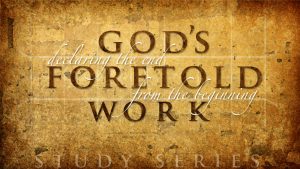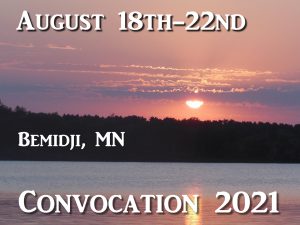Brother Reggie,
An easy question: do you think the Anti-Christ and his false prophet are Jews? As Jesus and his prophet were, it seems to me it would be required that they would also be Jews. But what thinkest thou?
Yes, the question is easy, but not so much the answer, since to show the scriptural case for my view would require more time than I can take out just now.
I fully appreciate your sense of symmetry concerning what would indeed seem appropriate for the Antichrist to be a false messiah and the false prophet to be analogous to John the Baptist as a forerunner of the Messiah, but for a number of reasons (some I’ve touched on slightly before), I do not believe the Antichrist will present himself to the Jews as their Messiah, but to the Muslim world as the incarnation of Allah.
The only thing clearly stated about the geographical origins of the Antichrist is found in Dan 8:9 and 11:21. There he is depicted as coming out of one of the four ‘notable horns’ (i.e., one of the four divisions of Alexander’s kingdom).I believe his origins in both geography (Dan 8:9; 11:21) and descent (spiritual if not entirely genetic), will be from among the descendants of Ishmael and Esau (Ps 83; Isa 34:5-6, 8; Ezek 35-36, Obadiah 1:6-17) together with those nations (Ezek 38:5-6) that will support them in their final prosecution of “the everlasting hatred” (Ezek 35:5). Hence, I believe that the ten kings allied with the Antichrist will be Islamic, if not entirely Arab. For reasons I hope to explain in future correspondence, I’ve had this view since 1973 when the Lord revealed it during the Yom Kippur War.
Whether or not I am correct in my view of the ten kings, it should be evident to anyone that the Antichrist, regardless of his origin, will be able to command the forces of the Islamic world through a common hatred of what Daniel calls “the holy covenant” (Dan 11:28, 30). Not only in Daniel, but in the larger context of Old Testament prophecy, this final war against the covenant is depicted as a presumptuous defiance of God’s claim to the Land, the city of Jerusalem, and the sacred institutions of a restored Jewish worship. (Side note: The sacrifices that will be restored by unbelieving Jews are entirely without efficacy. This will become clear when they find themselves again cast out of the Land in flight from the Antichrist. Still, the “holy pace” in Jerusalem has real significance. As a divinely commanded token of the covenant, it remains holy and set apart, not simply because it is sacred to Jews, but by reason of the Word of God. Its sanctity does not inhere in the faith of the worshippers, but in the authority of the God who elects. This is why Satan desires to defile the place that bears God’s name, and to possess the city from which the Son is destined to rule all nations; Ps 2:1-12; Ps 48:2 with Isa 14:13).
Note that it is this act in particular that constitutes the supreme offense. It is the ultimate provocation that causes God’s fury to come up in His face (Isa 63:3-4; Ezek 38:18; Joel 3:2). It is my prayer that the church will give itself to investigate what this issue of the Land means to God and why it represents what it does. I believe it is the issue of His sovereign right to choose as He will choose, His rule, which to ignore or defy is to challenge the very Word of God. It is the test of “has God really said?”
“The controversy of Zion” (Isa 34:8; Zech 12:2-3) will be a re-visitation of the quarrel that began in the tents of Abraham, which, according to the literal interpretation of prophecy, reaches its climax in the days just before Christ’s return, when Esau’s anguished cry of protest is raised once again against Jewish covenant claim, particularly as it pertains to the Land. However, Scripture shows that beyond the bitter judgements of the unequaled tribulation of Jacob’s trouble, the remnant of Edom (Amos 9:12), as also Assyria and Egypt will turn to the Lord to become the third with Israel, “even a blessing in the midst of the land” (Isa 19:24-25). We are reminded of the scene in Genesis when Jacob goes out with a limp to meet his brother. After a long night of intense wrestling with the Angel of the Lord’s presence, the once scheming Jacob, divinely touched in the ‘thigh of his strength’ (Deut 32:36 with Dan 12:7), has become the broken and contrite Israel of God, able now to bless all nations through the indwelling Spirit of Christ.
[Side note: Of course, the issue of ‘divine right’ to the Land has nothing at all to do with Jewish ‘worthiness’. It is the issue of God’s irrevocable calling and election (Ro 11:29). In that sense alone, Israel is counted by God as ‘holy’ in the sense of set apart (Ro 11:16), even before they are made personally holy by the powerful intervention of God (Ps 110:3; Isa 66:8; Zech 12:10) at the “set time” to favor Zion (Ps 102:13; Ro 11:25-29). It is no accident that the question of Jerusalem is the perennial “sticking point” in every effort to achieve peace in the region. Prophecy calls the Land “My land” and “their land”, despite the fact that its Jewish inhabitants are outside of covenant favor and appointed to “Jacob’s trouble” (Jer 30:6-7; Dan 12:1; Mt 24:21), which is the climax of what God calls “the vengeance of the covenant” (Lev 26:25). I point this out only because many prominent leaders in evangelicalism are now declaring that the Jew has no “divine right” to the Land, at least not until they are made personally holy through regeneration. However, if the modern contention over the Land has no more covenantal significance than ‘a border dispute between Mexico and the United States’, then why does prophecy depict the age coming to its predestined end over this very question?]
“After the league made with him” (Dan 11:23), this “vile person,” who is also a “king” (Dan 11:36) of a comparatively smaller province (“a little horn”), “begins to work deceitfully, as he comes up and becomes strong with a small people” (Dan 11:23). Here is a key passage that many commentators (with a few notable exceptions) wrongly assign to an alleged fulfillment in the second century B.C., supposing it to be fulfilled by the Syrian tyrant, Antiochus Epiphanes IV. Even where Antiochus fulfilled certain aspects of the prophecy, the fulfillment is by no means exhaustive. In fact, some aspects were not fulfilled by Antiochus at all, suggesting more of the relationship between type and anti type. In certain particulars Antiochus IV indeed prefigures the coming Antichrist, but in other details noted in the prophecy, the Antichrist is unique and without precedent.
If we take the view that Dan 11:23 is a reference to the coming Middle East peace covenant (as I believe we must for a number of reasons I hope to set out in a future writing), then it follows that this event marks the beginning of the last seven years (Daniel’s seventieth week; Dan 9:27 with Dan 11:31; 12:11). This would also mean that the events that occur between Dan 11:23 and Dan 11:31 happen within the first 3 1/2 years and therefore signal the approach of the desolating sacrilege that starts the second half of Daniel’s seventieth week, the last 3 1/2 years. We believe that this chronological sequence of signal events will profoundly affect the preparation and readiness of the saints for the great tribulation.
BEFORE he invades Jerusalem ‘at a time of security’ (Isa 28:18; Ezek 38:8; 39:26; Dan 11:23-24; 1Thes 5:3), the one who will be revealed as the Man of Sin (Dan 11:36-37; 2Thes 2:4) will first conquer a king to his south (Dan 11:25-26). After the battle, the defeated king of the south joins the victorious king of the north in what appears to be a plot against Jerusalem (Dan 11:27). Momentarily defeated in their plan (“for yet the end shall be at the time appointed,” which we may be sure entails the final desolation of Jerusalem, the evident goal of their clandestine plan), the victorious king persists in his ambitions against the holy covenant. He now turns back to have “intelligence” with others throughout the region that are equally opposed to the holy covenant (Dan 11:30). This will most likely be some kind of secretive counsel among those who are planning the overthrow of Jerusalem, since Israel will not know his plans until it is too late). .
I believe that the ten kings that give their strength and power to the beast (Dan 7:24; Rev 17:12) will be those who are angrily opposed to the holy covenant (Note that In Dan 9:27 the Antichrist (“the prince that shall come”) confirms (strengthens or gives formal approval) the covenant with many. This implies that the Antichrist will give a pretentious and insincere acknowledgement of Jewish right to the Land (the holy covenant; Dan 11:28, 30). Evidently, the new political situation that is brought about through ‘the league’ made with the Antichrist (Dan 11:23) opens the way for the orthodox party in Israel to proceed with their plans to restore the temple service in Jerusalem).
After the Antichrist conquers a mighty army to his south (Dan 11:25-26), a defeat that was aided by internal treachery (Dan 11:26), both of these kings, the conqueror and the conquered, sit together at one table to devise what appears to be a joint plot against the holy covenant, i.e., Jewish possession of Jerusalem.
Though momentarily disappointed in their plans to take Jerusalem (Dan 11:27), the Antichrist does not relent in his ambitions against the holy covenant until a third southward advance is successful, as Jerusalem is overwhelmed by invading armies (compared to a flood in both Dan 9:26 and Dan 11:22). At this time, the abomination of desolation is placed in the inmost part of the sanctuary, as the city is taken and the holy places overrun by the gentiles (Isa 63:18; 64:10-11; Rev 11:2). A comparison of Dan 11:31 with Dan 12:1, 11, and Mt 24:15-16, 21 shows beyond dispute that this is the event that begins the great tribulation.
Now let me tell you something that for me seems very compelling. It was suggested to me by a close brother, Travis Bennett, who lived with us on our farm in Texas before we moved to Ben Israel; it has never left me. Travis pointed out that the Antichrist who begins as a “little horn” (head of a smaller country or province) and who significantly comes up “AFTER” the other ten (Dan 7:24), is shown later to come into what is evidently a much more sizable kingdom through deceit and intrigue (Isa 28:15; Dan 8:25; 11:21, 23).
Scholars working on the assumption that the prophecy refers to Antiochus Epiphanes IV in the second century B.C. neglect to explain how Antiochus’ ascent to the throne of Syria, one of the four “notable horns” of Alexander’s divided kingdom (Dan 8:8-9, 22-23) could be considered a ‘little horn’ (an insignificant power). In the second century B.C., the kingdom of Syria was not an insignificant power. Nor did Antiochus unite under him a confederacy of ten kings.
So how does the vile person of Dan 11:21 proceed from his original capacity as a ‘little horn’ to become regent over a much larger domain, as the new head of the ten nation confederacy that is violently pledged to seize possession of Jerusalem? (Dan 11:45 with Rev 11:2).
Travis suggested that the ‘little horn’ might be the “Johnny-come-lately” to the region, as the newly formed Palestinian state that is currently so much the goal of international politics. Whether this comes about, it certainly makes sense. It seems to me a very viable possibility to keep in mind, as we watch events unfold.
According to Dan 11:23, it is “AFTER the league made with him,” that the ‘vile person’ of Dan 11:21 begins to work deceitfully. Significantly, the scripture says “he comes up and becomes strong with a ‘small people’, as he distributes the wealth among his followers “during a time of security” (Dan 11:23-24). The context assumes that Israel has now entered into its ill fated covenant with death and hell presuming that they will now have a secure peace (Isa 28:15; Ezek 38:8; 39:26; 1Thes 5:3), but it is a delusion that will end in a flood of sudden destruction.
Travis pointed out that according to Dan 11:21 there has been a momentary power vacancy in one of the ‘notable horns’ (Daniel’s imagery for the four divisions of Alexander’s kingdom), possibly Syria. The ‘vile person’, who is manifestly the ‘little horn’ of Dan 8:9, is someone who does not stand in the natural lineage of royal succession. This means that under ordinary circumstances royal honors would never have been conferred upon the man who will soon be manifest as Israel’s destroyer, the one we call the Antichrist. But here, contrary to all precedent, this ‘vile person’ “comes in at a time of security and obtains the kingdom by flatteries” (Dan 11:21).
This would mean that sometime after the false peace covenant (“the league made with him”), the Antichrist “through craft” (Dan 8:25) exploits an opportunity to move from a small power to one that is sizable and able to unite the ten kings against the holy covenant.
I do not hold this view with any final conviction, but until I can be shown a more compelling body of evidence to the contrary, I favor it over anything else I’ve heard. Though I hold it tentatively for now, I have the sense that this scenario may well prove to be more than a reasonable theory.
Finally, I personally do not expect that Jews, so far as it is known that they are Jewish, to have even the opportunity to take the mark of the beast. From the middle of the week till the end of the tribulation, Jews will be targeted for total destruction, because Satan knows better than the church that Jewish survival is necessary for the fulfillment of the everlasting covenant. I also believe that the test of the Jew will further distinguish the true church from the false, since to offer them assistance at that time will be a capital offense. Moreover, I believe it is the church’s part in ‘helping the woman’ that draws down upon its head the wrath of the Antichrist.
Appreciatively, your brother, Reggie




